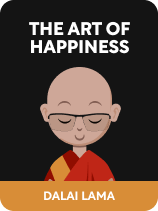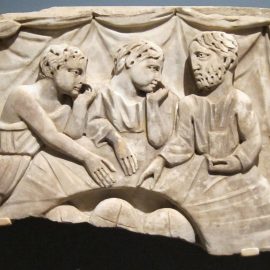

This article is an excerpt from the Shortform book guide to "The Art of Happiness" by Dalai Lama. Shortform has the world's best summaries and analyses of books you should be reading.
Like this article? Sign up for a free trial here .
What is the Dalai Lama and Howard C. Cutler’s The Art of Happiness about? What is the Dalai Lama’s advice for achieving happiness?
In The Art of Happiness, the Dalai Lama and psychiatrist Howard C. Cutler outline the Dalai Lama’s beliefs on how to achieve greater happiness in life—by training yourself to be happier. The Dalai Lama’s advice for achieving happiness is unique in its simplicity and flexibility: be empathetic, accept your suffering, learn about your mind.
Here’s a brief overview of the key ideas.
Achieving Happiness Requires Training
In The Art of Happiness, the Dalai Lama and psychiatrist Howard C. Cutler outline the Dalai Lama’s beliefs on how to achieve greater happiness in life—by training yourself to be happier. They present four types of happiness training:
- Cultivating a Happiness Mindset
- Building Strong Interpersonal Relationships
- Working to Eliminate Suffering
- Weaving Spirituality Into Daily Life
(Shortform note: To help distinguish between a capacity for happiness and the actualization of happiness, think of a special talent, like playing the piano. Just because you have a gift for the piano doesn’t mean you can play a sonata right away. You need to hone your talent through practice and education. Similarly, just because you have an innate capacity for happiness doesn’t mean you know the steps to be happy. You must learn and practice.)
1. Cultivating a Happiness Mindset
The first of the Dalai Lama’s four ways to be happy is to change your thoughts and state of mind to be more conducive to happiness.
(Shortform note: Some might argue that the idea of changing your mind to be more conducive to happiness isn’t realistic. Especially those suffering from PTSD might experience such significant psychological hurdles in daily life—anxiety, difficulty concentrating, flashbacks, and so on—that the prospect of overcoming them by changing their patterns of thought is impossibly difficult.)
Happiness is a mindset you build and isn’t contingent upon external characteristics, like wealth or status, says the Dalai Lama. Such factors can’t confer lasting happiness. You see this in daily life, adds Cutler: When something great happens, like a promotion, you’re temporarily elated but soon return to your normal level of contentment. Similarly, if you suffer a setback, like a breakup, the negative feelings wear off.
(Shortform note: In science, the phenomenon the Dalai Lama and Cutler refer to—the “wearing-off” of positive or negative emotions—is called hedonic adaptation. What’s more, when positive or negative events are repeated, they have a less pronounced effect on mood, and mood returns more quickly to the baseline. If you keep getting promoted, for instance, the promotions will leave you less happy for less time.)
The Dalai Lama believes there are three steps to cultivating a happiness mindset: education, development of motivation, and exertion. We’ll look at each step individually.
(Shortform note: Other parts of Buddhist teachings are separated into three steps comparable to the ones outlined by the Dalai Lama here. The Threefold Way, for instance, consists of first establishing self-discipline (or ethics), then concentration (or meditation), and finally, wisdom.)
Step 1: Educate Yourself
To cultivate your happiness mindset, educate yourself both about your emotions and the circumstances that give rise to them, counsels the Dalai Lama. By doing this, you root out the misunderstandings of the world that lead to negative emotions and therefore unhappiness.
To perform this educational self-analysis, think about when you’re happy and unhappy. Then, consider the feelings that led to your happiness or unhappiness. You’ll find that feelings like anger and hatred make you unhappy and hurt you and others, says the Dalai Lama. Because they’re hurtful, you’ll know these are negative emotions and that they’re based on a misunderstanding of the world.
| Education and Karma Buddhists refer to the state of being educated about yourself as “clear-knowing.” We can conceptualize this as “wisdom.” Wisdom has advantages beyond rooting out misunderstandings, negative emotions, and unhappiness: It prevents negative karma from being created. Karma is positive or negative energy that lives on your “resume of life.” If you intentionally do evil, you’ll have bad karma on your resume, which will negatively impact your future lives: Bad karma might cause you to be reborn as a non-human being, like an animal or ghost. Such creatures are less able than humans to work toward enlightenment, or Nirvana, and escape the cycle of rebirth. If you do good, though, you’ll have good karma on your resume, which will positively impact your future lives: You may be born as a human with a greater capacity to reach enlightenment than, say, a dog. When you’re wise, or clear-knowing, you’re more likely to make choices that build positive karma, thereby keeping your “resume of life” looking good. |
Step 2: Develop Your Motivation to Change
After educating yourself on how and why you become happy or unhappy, the next step of cultivating a happiness mindset is to develop your motivation to change your mindset, advises the Dalai Lama.
Simply understanding what makes you unhappy can’t alone eradicate unhappiness, claims the Dalai Lama. You must desire to rid yourself of unhappiness and negative emotions.
(Shortform note: Cutler and the Dalai Lama tell you to motivate yourself to change but don’t provide tools for doing so. One way to cultivate motivation is to write down the goals you hope to achieve—for instance, to rid yourself of ignorance. Achieving enlightenment is a long and winding path, but by writing down your goals, you help yourself stay on that path.)
Step 3: Exert Yourself to Change
Now that you’ve developed the motivation to change your mindset, the final step of cultivating a happiness mindset is to make the effort to change, says the Dalai Lama. We’ll discuss two strategies to make that effort.
(Shortform note: This chapter falls within the Right Effort step of the Noble Eightfold Path because the following strategies concern altering your thinking—not, as you might think, your actions. In the book, Cutler and the Dalai Lama spend the most time on the Meditation and Wisdom parts of The Threefold Way, and little time on the Ethics part, which concerns behavior, speech, and livelihood.)
Strategy #1: Develop Your Self-Worth
According to the Dalai Lama, to actively cultivate your happiness mindset, develop your sense of self-worth, regardless of external circumstances. You don’t need possessions, beauty, or titles to validate you as a human. It’s important to not attach your self-worth to such things, he adds, as they can diminish over time, meaning your self-worth does the same.
(Shortform note: Developing your self-worth is important for practical reasons, too: When you lack self-worth, you might engage in destructive behaviors in your quest to “earn” your right to exist. In Dare to Lead, Brené Brown writes about employees who overwork themselves to prove their worth. This has negative consequences for the individual and the company.)
Strategy #2: Combat Negative Emotions With Positive Ones
When they arise, counter negative emotions with positive ones, says the Dalai Lama. For instance, when you find yourself consumed with self-reproach over a bad test grade, tell yourself that your worth isn’t dependent on grades and practice kindness toward yourself.
(Shortform note: For Brené Brown, self-compassion is a key tool for combating negative feelings, particularly harmful perfectionism. Brown breaks self-compassion into three parts: 1) self-forgiveness, 2) self-awareness, and 3) recognition that you’re not the only person struggling with negative feelings.)
2. Build Strong Interpersonal Relationships
We’ve discussed the first form of happiness training: cultivating a happiness mindset. Now we’ll turn to the second form of happiness training: building strong interpersonal relationships. First, we’ll describe how our happiness is linked to other humans. We’ll then outline the Dalai Lama’s recommendation for establishing connectedness to others to increase our happiness.
We Need Other Humans to Be Happy
The Dalai Lama believes that all humans are dependent on others for their wellbeing and happiness. To prove this, he points to the fact that others provide the material goods and services we rely on for survival. Many people built your home, made the food you eat, and contributed to your education.
(Shortform note: Even in today’s tech-driven society, in which we could survive for months without seeing another human, survival remains contingent upon the efforts of many people. Even an action as impersonal as ordering off Amazon requires the input of many: those who created the algorithms that keep warehouses stocked, those who keep your information safe, those who fulfill your order and deliver it to your home, and so on.)
Form Many Intimate Relationships
Since other humans are integral to your happiness, it’s essential to form strong connections with them. The type of connection you forge matters: According to the Dalai Lama, you should establish intimacy between yourself and many different people. Humans have defined intimacy differently across cultures and time, and there’s no overarching definition. In this book, Cutler and the Dalai Lama propose that an intimate relationship is one in which you’re open with the other person and experience a connection.
(Shortform note: It’s true that the level of intimacy you establish with others matters to your happiness. Someone with many loose connections can feel lonelier than someone with only a few close friends. Similarly, relationships marked by conflict and a lack of trust can fail to provide a sense of connection. However, individuals also have different tolerances for alone time and therefore, someone with a few close friends might still long for more connection because they don’t enjoy being alone. Optimizing your social life is a balancing act, so listen to your unique needs.)
3. Work to Eliminate Suffering
The third form of happiness training is working to eliminate suffering. Suffering is an inescapable fact of life, says the Dalai Lama. Everyone suffers, and attempts to free yourself from it—like through excessive drinking, drug use, or eating—provide only temporary relief or exacerbate the suffering. What’s worse, often, the destructive ways you avoid suffering become part of who you are. If you habitually transform your suffering into anger towards others, you become an angry person.
(Shortform note: It’s easy for suffering to lead to bad habits—as the Dalai Lama suggests—because of how the brain forms habits. According to Charles Duhigg in The Power of Habit, habits begin as conscious choices—to avoid suffering, for instance—which become automated loops. The reward at the end of the loop reinforces its validity, and the loop becomes a habit. For instance, you might suffer during a bad meeting with your boss and take your anger out on your family, which gives you relief. The relief reinforces the helpfulness of this loop in your mind, and it becomes a habit.)
If Suffering Is Inherent, Why Talk About It?
Viewing suffering as a fact of life may seem like it just causes more suffering, rejoins Cutler. It therefore might seem best to avoid thinking or talking about suffering.
(Shortform note: Many people take Cutler’s avoidance approach to unpleasant areas of their lives. But avoiding problems by procrastinating, ruminating, or behaving passive-aggressively usually only exacerbates the problem. Avoidance thus typically leads to suffering on all levels of your life.)
But there’s additional context in the Buddhist tradition that makes this discussion of suffering not only valuable but necessary, says the Dalai Lama. Buddhists believe that you can eliminate suffering. In Buddhist philosophy, ignorance, hatred, and craving create suffering. When you start eliminating those root causes of suffering, you move toward freedom from suffering.
(Shortform note: The Dalai Lama discusses your ability to eliminate suffering but doesn’t discuss what will happen once you do this. In Theravada Buddhism, once you’ve eliminated suffering, you become an arhat—someone who’s attained Nirvana, spiritual enlightenment. There are four stages of becoming an arhat, each one involving the elimination of different cravings, forms of anger, and types of ignorance.)
To Free Yourself From Suffering, Accept Your Suffering
Acceptance of suffering is the first, integral step toward eliminating it, says the Dalai Lama. If you can’t accept that life is suffering, you’ll only ever apply spot solutions to your suffering—like the destructive forms of numbing described above. You won’t free yourself from its root causes of ignorance, hatred, and craving.
(Shortform note: Acceptance is also an important step in addiction recovery programs, usually seen as the first, foundational step on the road to recovery. It encompasses acceptance of your addiction and how it’s affected your life, acceptance of yourself and your flaws, and acceptance of the challenges you’ll encounter as you recover from your addiction.)
4. Weave Spirituality Into Daily Life
The Dalai Lama’s fourth and final form of happiness training is weaving spirituality into daily life. According to the Dalai Lama, weaving spirituality into your life means taking every opportunity in your day-to-day to practice a spiritual teaching or derive a spiritual lesson.
(Shortform note: Science confirms the Dalai Lama’s belief that spirituality makes you happier: Studies have shown that those who have spirituality or religion in their lives tend to be happier and less depressed and anxious than those who don’t.)
Practice whatever form of spirituality you subscribe to, says the Dalai Lama: a religious spirituality, guided by the tenets of a religion, or a secular spirituality, guided by the values of kindness, compassion, and so forth.
(Shortform note: There’s debate over whether Buddhism itself is a religion or a philosophy. Those who believe it’s a religion do so because Buddhism, like other religions, proposes that there’s a single, true reality (Nirvana). Those who believe Buddhism is a philosophy argue that Buddhism doesn’t propose a single reality, but rather some testable propositions to eradicate suffering from your lie.)

———End of Preview———
Like what you just read? Read the rest of the world's best book summary and analysis of Dalai Lama's "The Art of Happiness" at Shortform .
Here's what you'll find in our full The Art of Happiness summary :
- The Dalai Lama's Buddhist path toward happiness
- The use of scientific evidence to support the Dalai Lama's beliefs
- Concrete actions you can take to improve your outlook on life, relationships, and resilience






